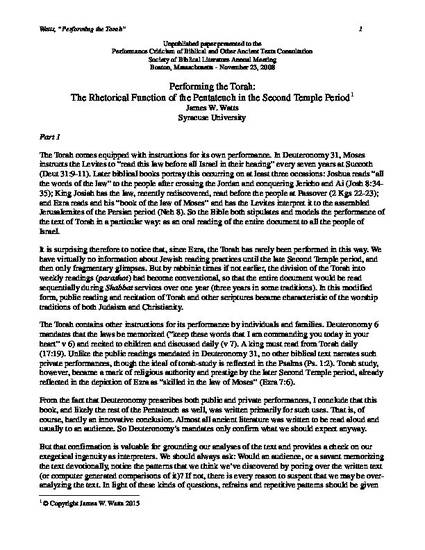
Presentation
Performing the Torah: The Rhetorical Function of the Pentateuch in the Second Temple Period
Religion - All Scholarship
ORCID
James W. Watts: 0000-0002-4872-4986
Document Type
Presentation
Date
1-1-2008
Keywords
- Pentateuch,
- Torah,
- rhetoric,
- reading aloud,
- scripture,
- performance
Language
English
Disciplines
Description/Abstract
The Torah comes equipped with instructions for its own performance: a public reading of the entire scroll before the assembled people of Israel (Deut 31:9-11). The books of Kings and Nehemiah portrays similar ceremonies occurring in 7th and 5th century Jerusalem (2 Kgs 22-23; Neh 8). Yet later liturgical readings have rarely presented the entire Torah scroll at one time. Juxtaposition of biblical depictions of public readings with rhetorical analysis of the Pentateuch’s contents as well as evidence for its uses in the Second Temple period provides a test case for evaluating the possibilities and limitations of performance criticism of ancient texts.
Source
local input
Creative Commons License
Creative Commons Attribution-NonCommercial-No Derivative Works 4.0 International
Citation Information
James W. Watts, “Performing the Torah: the Rhetorical Function of the Pentateuch in the Second Temple Period,” unpublished conference presentation, 2008.

Unpublished paper presented to the Performance Criticism of Biblical and Other Ancient Texts Consultation Society of Biblical Literature Annual Meeting Boston, Massachusetts - November 23, 2008